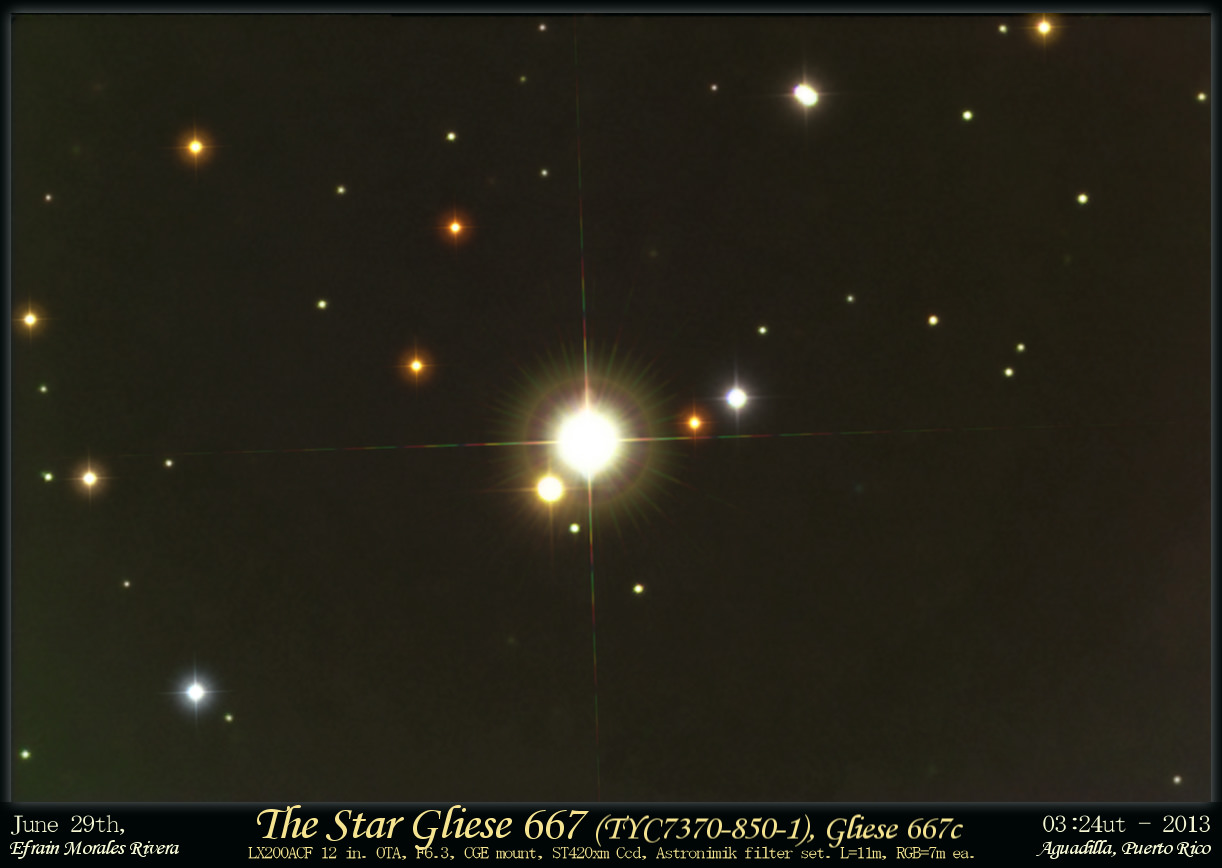Here is a great new observation of the triple star system Gliese 667 from astrophotographer Efrain Morales of the Jaicoa Observatory in Puerto Rico. Recently, one of the stars, 667 C was found to have perhaps seven planets orbiting it! If all seven planets are confirmed, the system would consist of three habitable-zone super-Earths, two hot planets further in, and two cooler planets further out. Scientists say that the ‘f’ planet is “a prime candidate for habitability.”
Efrain also created an animation of the star system, showing the stars’ movements:
The animation was created using plates from the DSS (Digitized Sky Survey) with the final image in the animation from Efrain’s observations.

The system is in the constellation of Scorpius and is just barely visible to the unaided eye at magnitude 5.9 – appearing as a single point of light. The three stars orbit each other in a complicated dance. The two brightest components of this system, Gliese 667 A and Gliese 667 B, are orbiting each other at about 13 times the separation of the Earth from the Sun, while Gliese 667 C is the smallest stellar component of this system, and orbits the other two stars at about 230 AU.
Efrain used a LX200ACF 12 in. OTA, F6.3, CGE mount, ST402xm CCD, Astronomik LRGB filter set.
Thanks to Efrain Morales and the Jaicoa Observatory for providing this latest look at an extremely interesting star system!
Want to get your astrophoto featured on Universe Today? Join our Flickr group or send us your images by email (this means you’re giving us permission to post them). Please explain what’s in the picture, when you took it, the equipment you used, etc.


It is speculation for now. We need better equipment and technology. So far, it is a guessing game of sorts. Until we get concrete proof up close and very personal. It is just speculation. Just like the “Show Me State of Missouri”. Show Me, …Proof! Although, It is sure fun and exciting to be on the cusp of discovery! 😉
I don’t think you can call such observations a “guessing game.” Of course scienific observations need to be confirmed with additional tests; replication is essential to science. But our ability to identify and understand complicated exo-planetary systems through observations of orbital perturbations is not really in question. It has been frequently confirmed through transit-eclipse observations and even in a couple of cases direct telescopic imaging. The fact that you and I do not understand the complex mathematics does not make it merely “speculation.”
Well said Latinist. Speculation is a poor choice to describe the advancement made in the last two decades with respect to the discovery of extrasolar systems. We are at the infancy in this exciting field of Cosmology, and I await many more astounding discoveries.
LOL! What else is it called in your vocabulary imagination?
A blink? A warble? And? Its a guessing game. Maybe it is maybe it isn’t. When we can see planets like Mars, Venus, Jupiter. Then I will agree. Other wise its a guessing game of sorts. Many other scientists confesses the same thing.